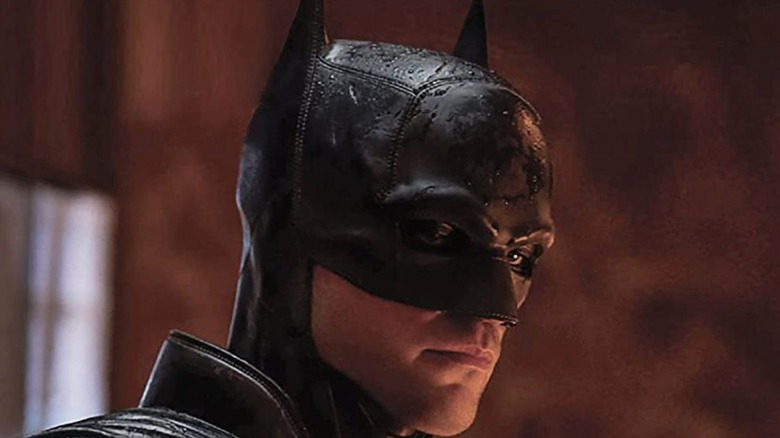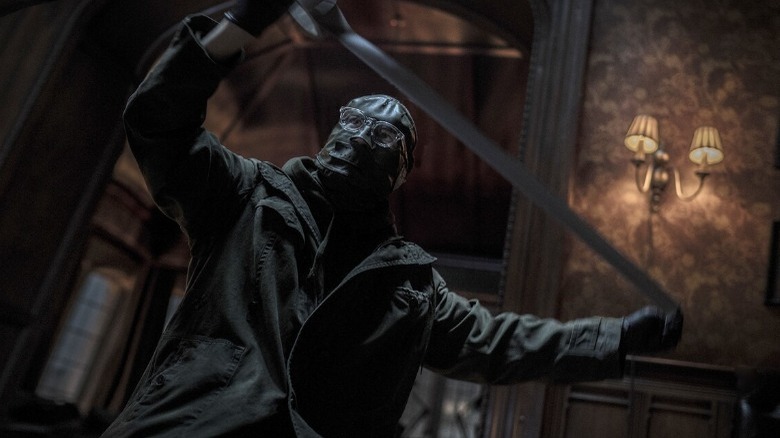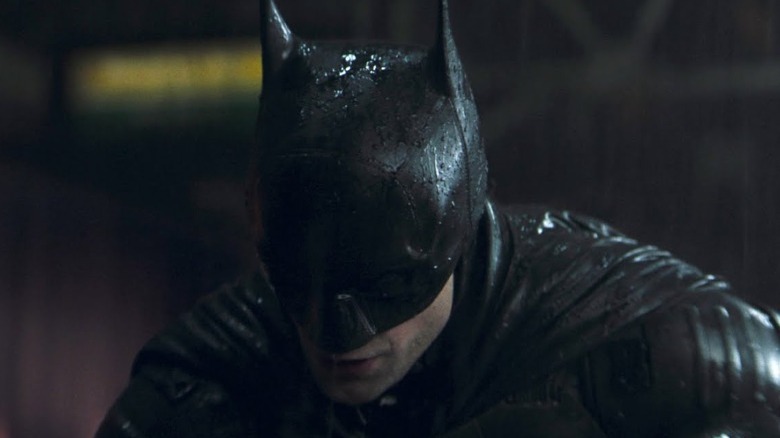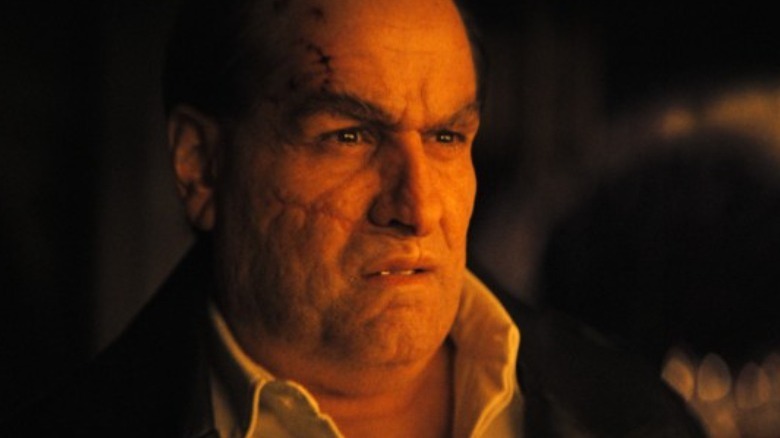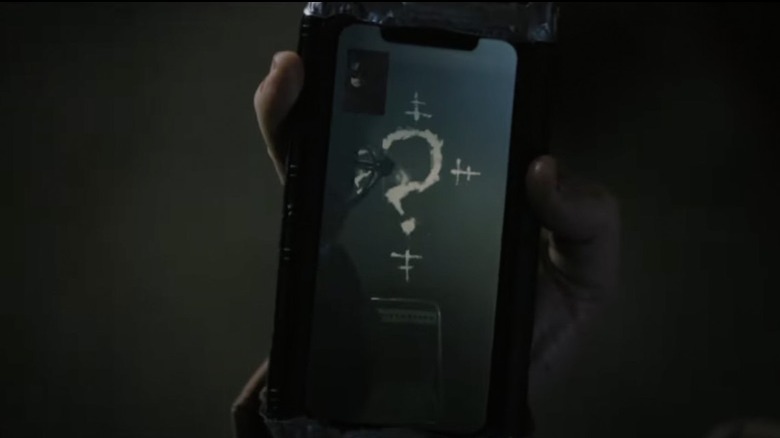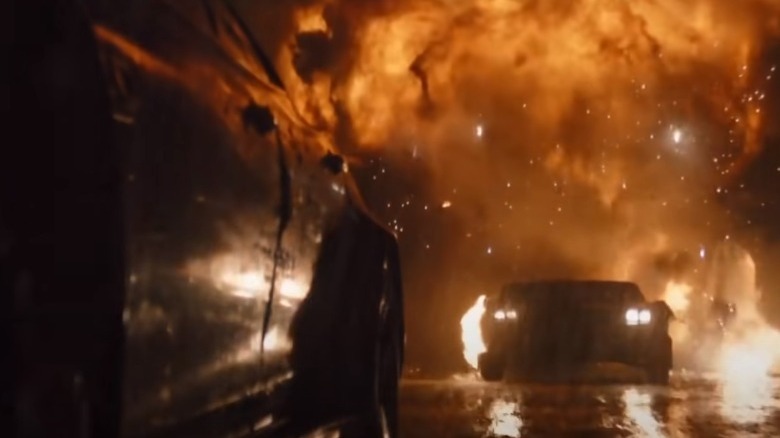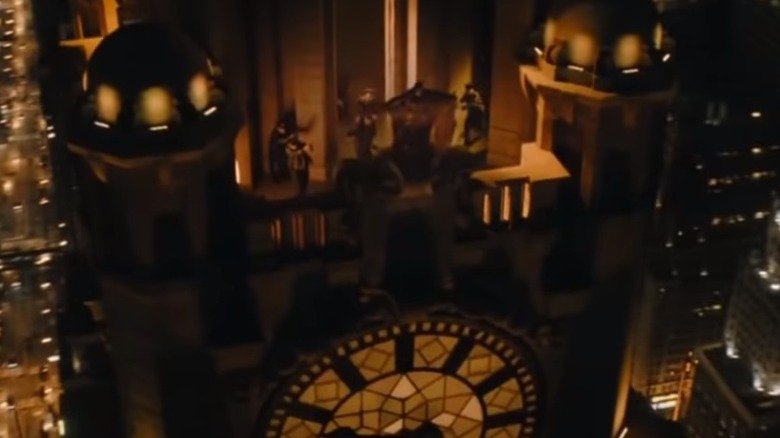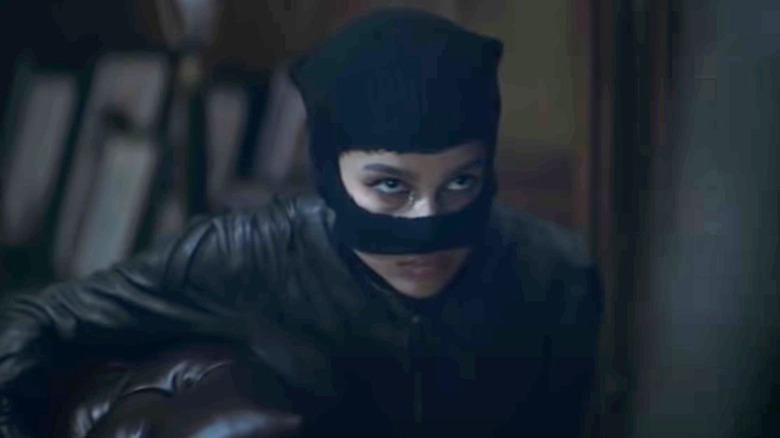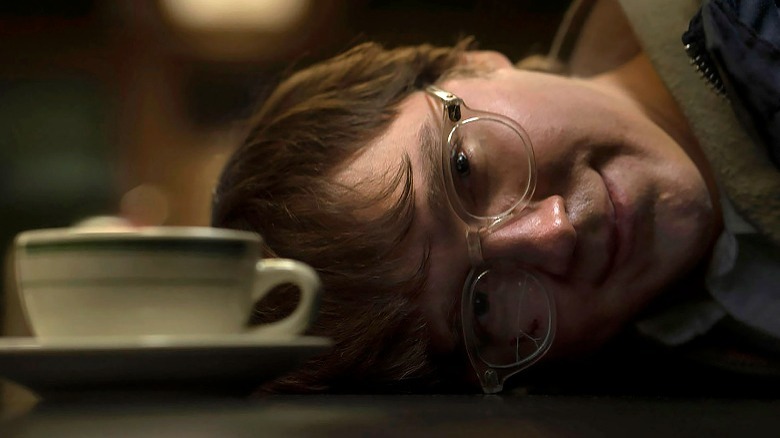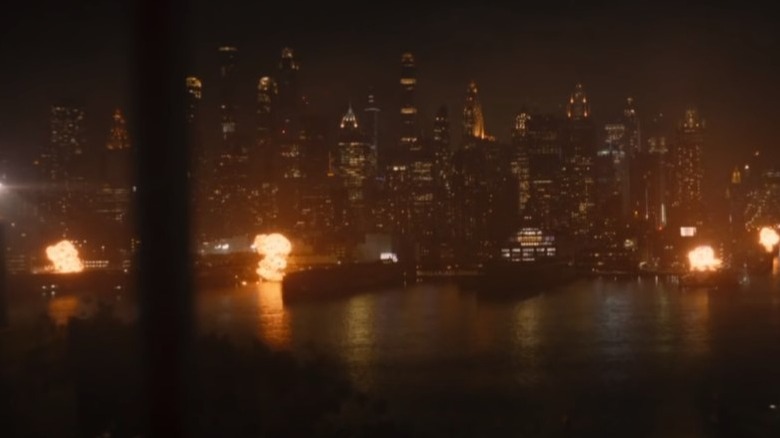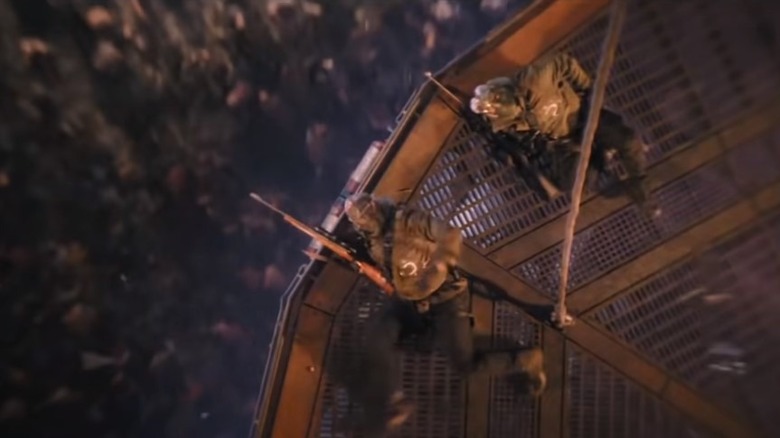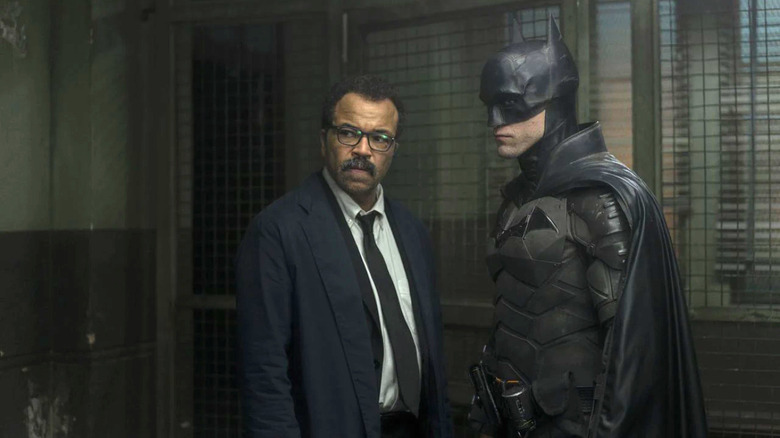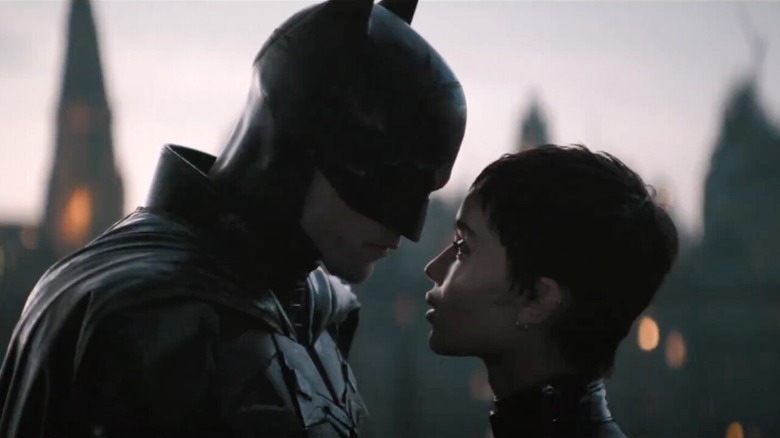The Most Pause-Worthy Moments In The Batman
Pulse-pounding action sequences juxtaposed with quieter but more sinister moments depicting an eerie trail of bloody messages from a domestic terrorist comprise the nearly three-hour runtime of "The Batman." It's a tale of intrigue, despair, and renewal. In fact, the word "renewal" is a term the Riddler focuses heavily on, as the leadership of Gotham's past failed in their promises to renew the city and aid the most poverty-stricken among them. The movie also focuses on Batman's own personal renewal as he learns to elevate his fight for vengeance to a higher, nobler plane — one focused on providing hope to the citizens of Gotham City.
The Dark Knight's crusade to exact vengeance on criminals is packed with intense combat sequences, high-speed chases, and some rather creepy imagery thanks to Paul Dano's take on the Riddler. In between the more intense moments of "The Batman," the film settles into a more contemplative groove as Jim Gordon and Batman work the Riddler case following his trail of clues. The camera work is top-tier, and Batman fans will definitely want to savor every detail of this neo-noir adventure. There are countless pause-worthy moments in "The Batman," so let's highlight some of the absolute best the film has to offer.
A terrifying serial killer
The opening sequence to "The Batman" will easily be one of the most talked about scenes simply due to the terror the filmmakers layer into every moment of the film's setup. It's akin to the swelling dread one feels as Michael Myers stalks his prey in a "Halloween" movie. And much like the intro sequence of 1978's "Halloween," viewers begin the film gazing through the eyes of an enigmatic killer as he spies on his victim — in this case, Gotham's mayor and incumbent frontrunner for the next election, who sits unsuspecting in the privacy of his luxurious abode. As the mayor views the public reaction to his own campaign being broadcast on television, he's entirely unaware of the danger that lurks in the shadows of his own home.
Hauntingly, the figure of the Riddler is seen lying in wait not even five feet away from his intended victim as the target paces the floor and talks on the phone. Paul Dano's acting skill is on full display here — he can make your skin crawl with just the movement of his eyes as the Riddler stalks his prey. There's a lot to savor in this sequence for a viewer — particularly those who have an appreciation for horror themes, who'll thrill to the horrific imagery of this murderous stalker in action.
Batman's first appearance
The arrival of the film's star character is often cause for a grand entrance, especially for a character who's as popular as Batman. After the film moves on from its horrifying introduction to the Riddler, Robert Pattinson's Bruce Wayne speaks to the audience via a sullen voiceover that underscores the bleak and depressing outlook of a city riddled with crime. While he's unsure whether he's actually doing any good, there's one thing he is certain of: Criminals feel uneasy when the Batsignal shines in the sky, and for good reason.
On a subway, a gang that looks to be inspired by the Joker — their faces are painted in a manner not totally dissimilar from the Clown Prince of Crime — targets an unlucky soul and begins assaulting the poor man after disembarking the vehicle. Quickly, the sounds of footsteps can be heard from within the dark tunnel opposite the attackers. The gang stops their attack and looks on waiting to see what emerges from the dark. As Batman steps out into the light, he provides a demonstration of his fear-mongering tactics by brutalizing the gang's apparent leader in front of them. This results in fight mode for some and flight mode for others. It's a visceral display of Batman's rage, and the scene earns its place as a crowd-pleasing starting point for Batman's journey in the film.
Penguin's first appearance
Long before "The Batman" arrived in theaters, audiences knew for quite some time that the Penguin was going to have a role in the film. Given that the story takes place early in Batman's crimefighting career, the Penguin isn't quite the crime lord comics readers know him as — at least not yet: He operates the Iceberg Lounge under the mob-backed supervision of Carmine Falcone. Colin Farrell absolutely disappeared into the character beneath prosthetics and make-up work. Despite his altered appearance, he manages to nail the mannerisms of an egomaniacal crook vying for power. All the fun begins when the Dark Knight heads to the Iceberg and questions the Penguin regarding his possible associations with the recently deceased mayor.
As far as pause-worthy moments go, seeing the Penguin and knowing that Colin Farrell is buried beneath that grungy exterior and slimy attitude is quite impressive. Viewers might find themselves scanning the character for any identifiable semblance of the Farrell they remember, but they'll be hard-pressed to find anything. Despite his own penchant for crime and corruption, the Penguin positions himself as one of the film's more interesting characters, even though he has little to do with the burgeoning threat of the Riddler.
The Riddler's home
Throughout the film, the Riddler taunts the residents of Gotham with each fresh kill. Of course, he believes that he's doing the city a service by rooting out corruption. Ultimately, however, he also wants to get Batman's attention, hoping that the vigilante will side with him in his crusade to punish the wicked. The news cycle regularly shows recorded threats and snuff films that the Riddler has posted in an effort to gain clout and attention throughout his campaign. When law enforcement finally detains the Riddler, they investigate his apartment, which is littered with newspaper clippings and details of Gotham's past and present.
These video recordings and the Riddler's cluttered abode all contain secrets and details that many fans will certainly want to pause and scour for clues to a larger world beyond this film's version of Gotham City. When the Riddler discusses the affluent Wayne and Arkham families, eagle-eyed fans can see a clipping referencing Edward Elliot, another famous Gotham City aristocrat. Those who remember the Elliot family from the "Batman" comics will recognize this as a nod to Tommy Elliot, Bruce's former childhood friend, who grows up to become the villainous Hush — a character who could earn a spot in this Batman's rogues' gallery in the future.
The Batmobile chase
A Batman movie just wouldn't be the epic Dark Knight tale fans want without a thrilling Batmobile sequence. "The Batman" doesn't disappoint — Robert Pattinson's Batman unveils his monster machine with a thunderous rumble. As the Dark Knight pursues the Penguin in an effort to learn whether he's the informant on the Marconi case that Riddler has been referring to, he has to deal with the dangerous criminal's collateral damage. The Penguin enters the freeway driving in the wrong direction, dodging cars and causing massive pile-ups as he flees Batman's wrath.
While this Batmobile isn't seen employing the use of supplementary gadgets and weaponry, its sheer muscle and steel-body exterior make navigating this treacherous terrain without taking a terrible beating fairly simple. At one point, the Penguin causes a collision that includes a truck carrying liquid fuel. Looking in his rear view mirror, he believes the Batman was either forced to stop his pursuit or taken out in the explosion of the truck's trailer. He hollers for joy — but his excitement is short-lived, as the Batmobile comes careening out of the flames much to the Penguin's horror. Hot-rod enthusiasts and fans of the Batmobile will definitely want to admire the stunt work and thrilling visuals on display during this harrowing sequence.
The flying squirrel suit
Whether you're reading Batman's adventures in the comics or watching them onscreen, it's often necessary to suspend disbelief in order to simply enjoy the ride. Christopher Nolan's Dark Knight trilogy offered a slightly more grounded take on the saga, making the world of Batman feel almost plausible ... or did it? If physicists have any say in the matter, gliding with a cape as Batman is known to do is possible, but landing without leaving a Batman-sized stain on the pavement is not. In other words, Batman's antics as a vigilante in the Dark Knight trilogy aren't as anchored in reality as one might've thought — well, at least the part where he glides with a cape.
"The Batman" actually fixes that by outfitting the Caped Crusader with a very real-world wingsuit that comes coupled with a parachute for the rapid deceleration needed before Batman hits the ground. Of course, Pattinson's Batman doesn't exactly stick the landing — his parachute is caught by a bridge, smashing our hero into the cement and leaving him hobbling away in pain. Still, Batman's bruising embarrassment is viewers' gain — the wingsuit actually emerges out of his Batman suit, and a quick pause might be in order to see just how that occurs. After all, Batman wouldn't really live up to his name if he couldn't defy gravity at least a little bit.
Batman and Catwoman's first meeting
The relationship between Batman and Catwoman has long been one of the most entertainingly complex in the comics — and although it's yet to be fully explored on the big screen, audiences have had more than one opportunity to see the Bat and the Cat in action. Michelle Pfeiffer's take on the role, for 1992's "Batman Returns," is unforgettable, but Anne Hathaway put her own spin on the character when Selina Kyle fought side by side with the Caped Crusader in "The Dark Knight Rises." "The Batman," however, gives us what might be the most accurate portrayal of Catwoman yet, with Zoë Kravitz donning the leather bodysuit and cat-burglar mask.
When Batman follows Selina to find out how she's involved in the case at hand, he discovers her breaking into a safe and comments on her uncanny ability to crack them so easily. Startled, she turns around and begins to engage Batman in hand-to-hand combat. The sequence fits neatly into the narrative while doubling as thrilling fan service for everyone in the audience who's been looking forward to seeing these characters come together onscreen again. If viewers look closely, they can even see that Selina is sporting some wickedly long fingernails, prime for catlike scratch attacks. Thankfully, the clash is brief — just as they have so many times before, Batman and Catwoman quickly find an ally in each other.
Paul Dano's unmasked Riddler
Every film reaches an inevitable moment that hinges on the choices of narrative's participants. This pivotal moment in "The Batman" occurs after the Riddler snipes Carmine Falcone and then passively submits to arrest at a diner just down the street. Most of us are aware of the age-old movie trope that when a villainous figure willingly submits to the protagonist and the forces of justice, a sinister plot is likely about to boil over behind the scenes. Batman learns just how crazed the Riddler is as a person when he confronts him face-to-face with a hardened glass window between them.
The Riddler's hatred for Gotham's elite is deep-seated. His pain stretches all the way back to his childhood, when he was an orphan who lived in squalor thanks to corrupt politicians and police illegally sapping away funding that was meant to go to the poor and efforts to renovate the worst parts of the city. Paul Dano's performance is unforgettable. He's tortured, filled with hate, and completely unhinged — a state he's been pushed through years of negligence from a city that has long since forgotten about him and many others like him. His facial tics, jarring laughter, and piercing eyes say it all. The moment is one to be rewatched and appreciated if for no reason other than to simply bask in Dano's talent.
Gotham's apocalypse
Just as many viewers will no doubt suspect, the Riddler's capture isn't the end — but it does set up his endgame. Despite his arrest, he has power in the form of a group of radical followers he's amassed — and they detonate bombs he's planted on Gotham's reservoir walls, causing a devastating amount of water to pour into the city. When Batman finally comes to realize the Riddler's terrible plot, fiery explosions can be seen erupting throughout the city in a scene reminiscent of Bane's assault on Gotham in "The Dark Knight Rises."
The results are horrifying as residents of Gotham clamor to reach higher ground and water sweeps through the streets. The moment adds a bit of shellshock when audiences sit back and realize that the Riddler may have won. It's not often that the bad guy walks away as the victor, but this villain managed to bring widespread destruction to Gotham. The film's resolve settles on Batman understanding that he has to do whatever he can to help Gotham's innocents in the face of unrepentant evil.
Batman's battle with Riddler's followers
With the Riddler locked up tight at Arkham, he can no longer do any harm directly. But he's covered himself by rallying several extremists to his cause through his online presence in the preceding days, weeks, and months. With Gotham City flooding and descending into mass panic and chaos, the anarchists seek to assassinate the mayoral candidate and kill as many as they can at a political rally. The group positions themselves high up on a rafter where they rain down a hail of bullets upon the innocents below. Batman, once again, makes a grand entrance by demolishing the top of the building with explosives and dropping onto the rafter before engaging the Riddler's disciples. The Dark Knight pummels and decommissions bad guy after bad guy in a thrilling combat sequence.
Still early in his career, however, Batman isn't quite the near-perfect crimefighter we know Batman will one day become after accruing years of experience on the job: He's attacked from a blind spot and nearly falls off the rafters. But surveying his surroundings, he employs the use of smoke to distract his enemies while he takes each down one by one. There are plenty of pause-worthy moments throughout this thrilling sequence, watching the Dark Knight do what he does best.
Riddler's neighbor at Arkham
We're living in the age of the superhero franchise, so it's safe to assume that just about anyone who goes to see "The Batman" will be looking for any loose storytelling threads that could hint at sequels to come. Director Matt Reeves doesn't disappoint, leaving the audience with at least one tantalizing possibility. While the Riddler is sitting in his cell, watching the news cycle rally around Batman as a hero saving people from the floods, his neighbor in an adjoining cell seeks to console the villainous mastermind, offering the Riddler friendship and insisting that Gotham would love nothing more than to see him make a comeback. It's difficult to really identify the figure in the cell, but most indications point toward a character who's very, very familiar to Bat-fans.
Of course, viewers will want to pause to soak in all the details. The mystery man's hair is rather unkempt and his face appears deformed or scarred to some degree. It could possibly be Two-Face, given that Harvey Dent isn't the D.A. in this film, nor is he mentioned. However, the man's sinister cackle points persuasively to the Joker. Of course, it could be a red herring, but wherever Batman is, the Clown Prince of Crime can't be far behind.
Batman and Catwoman speeding away
The film establishes Batman and Catwoman's relationship well. Both have aided each other and even saved each other's lives. Their paths are interconnected, and Selina senses that when she kisses the Dark Knight. She pleads with him to skip town with her before realizing he's too fixated on helping build a better Gotham City. While she doesn't believe the city will ever change, Batman has hope.
As the two set off on their own paths, they speed away on their respective motorcycles. Despite this scene coming at the tail end of the film, it's the first moment viewers can admire the Batcycle in all of its simplicity and beauty. While bleak themes of corruption and darkness pervade "The Batman," seeing the Caped Crusader and Catwoman racing down the road together side by side offers a glimmer of hope and optimism for the future. Even though they ultimately go their separate ways, it's hard to believe Selina Kyle is out of Batman's life for good after all they've been through together.
